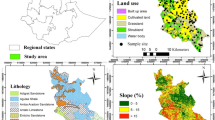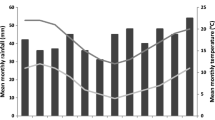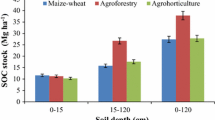Abstract
Soil aggregate stability has been known as one of the most important soil properties which is influenced by cultivation system. This study investigates the effect of different cultivation systems on aggregate stability indices in two statuses of dry (DSA > 0.25 mm) and wet (WSA > 0.25 mm). The study was done in six cultivation systems consisting wheat, barley, maize, alfalfa, fallow, and plowed farms. The results showed that aggregate stability indices affected significantly by the type of cultivation system. In contrast, no meaningful effect of soil depth (0–10 and 10–20 cm) on selected soil properties was observed. In addition, soil primary particles as well as organic carbon differed significantly between the cultivation systems. Wheat and alfalfa farms consisted of larger aggregates, while water-stable aggregate for wheat found to be in a greater degree. Moreover, wheat and barley showed the highest contents of organic carbon. The results of WSA > 0.25 mm indicated that the correlation coefficients for sand, silt, clay, and organic carbon contents were −0.67, 0.74, 0.12, and 0.70, respectively. Compared to the DSA > 0.25 mm, the effect of soil organic carbon on the WSA > 0.25 mm was arisen while the influence of clay fraction reduced.








Similar content being viewed by others
References
Alagoz Z, Yilmaz E (2009) Effects of different sources of organic matter on soil aggregate formation and stability: a laboratory study on a Lithic Rhodoxeralf from Turkey. Soil Till Res 103:419–424
Amezketa E (1999) Soil aggregate stability: a review. J Sustain Agr 14:83–151
Angers DA, Edwards LM, Sanderson JB, Bissonnette N (1999) Soil organic matter quality and aggregate stability under eight potato cropping sequences in a fine sandy loam of Prince Edward Island. Can J Soil Sci 79:411–417
Barthes BG, Kouoa Kouoa E, Larre-Larrouy MC, Razafimbelo TM, de Luca EF, Azontonde A, Neves CS, de Freitas PL, Feller CL (2008) Texture and sesquioxide effects on water stable aggregates and organic matter in some tropical soils. Geoderma 143:14–25
Bossuyt H, Denef K, Six J, Frey SD, Merckx R, Paustian K (2001) Influence of microbial populations and residue quality on aggregate stability. Appl Soil Ecol 16:195–208
Bronick CJ, Lal R (2005) Soil structure and management: a review. Geoderma 124:3–22
Denef K, Six J, Paustian K, Merckx R (2001) Importance of macroaggregate dynamics in controlling soil carbon stabilization: short-term effects of physical disturbance induced by dry-wet cycles. Soil Biol Biochem 33:2145–2153
Eynard A, Schumacher TE, Lindstrom MJ, Malo DD (2004) Aggregate sizes and stability in cultivated South Dakota Prairie Ustolls and Usterts. Soil Sci Soc Am J 68:1360–1365
Garcia-Orenes F, Cerda A, Mataix-Solera J, Guerrero C, Bodi MB, Arcenegui V, Zornoza R, Sempere JG (2009) Effects of agricultural management on surface soil properties and soil eater losses in eastern Spain. Soil Till Res 106:117–123
Green VS, Stott DE, Cruz JC, Curi N (2007) Tillage impacts on soil biological activity and aggregation in a Brazilian cerrado oxisols. Soil Till Res 92:114–121
Guerif J, Richard G, Durr C, Machet JM, Recous S, Roger-Estrade J (2001) A review of tillage effects on crop residue management, seedbed conditions and seedling establishment. Soil Till Res 61:13–32
Karunatilake UP, Van Es HM (2002) Rainfall and tillage effects on soil structure after alfalfa conversion to corn on a clay loam soil in New York. Soil Till Res 67:135–146
Kavdir Y, Killi D (2008) Influence of olive oil solid waste application on soil pH, electrical conductivity, soil nitrogen transformations, carbon content and aggregate stability. Biores Tech 99:2326–2332
Kemper WD, Rosenau RC (1986) Aggregate stability and size distribution. In: Klute A (ed) Methods of soil analysis. ASA and SSSA, Madison, pp 425–442
Li JT, Zhong XL, Wang F, Zhao QG (2011) Effect of poultry litter and livestock manure on soil physical and biological indicators in a rice–wheat rotation system. Plant Soil Environ 57(8):351–356
Marquez CO, Garcia VJ, Cambardella CA, Schultz RC, Isenhart TM (2004) Aggregate size stability distribution and soil stability. Soil Sci Soc Am J 68:725–735
Martens DA (2000) Management and crop residue influence soil aggregate stability. J Environ Qual 29:723–727
Mbagwu JSC, Bazzoffi P (1998) Soil characteristics related to resistance of breakdown of dry soil aggregates by eater drops. Soil Till Res 45:133–145
Opara CC (2009) Soil microaggregates stability under different land use types in southeastern Nigeria. Catena 79:103–112
Pansu M, Gautheyrou J (2006) Handbook of soil analysis, mineralogical, organic and inorganic methods. Springer. 993 p
Puget P, Chenu C, Balesdent J (2000) Dynamics of soil organic matter associated with particle-size fractions of water-stable aggregates. Eur J Soil Sci 51:595–605
Six J, Guggenberger G, Paustian K, Haumaier L, Elliott ET, Zech W (2001) Sources and composition of soil organic matter fractions between and within soil aggregates. Eur J Soil Sci 52:607–618
Taboada MA, Barbosa OA, Rodriguez MB, Cosentino DJ (2004) Mechanisms of aggregation in a silty loam under different simulated management regimes. Geoderma 123:233–244
Wang Y, shen J, Luo Y, Scheu S, Ke X (2010) Tillage, residue burning and crop rotation alter soil fungal community and water stable aggregation in arable fields. Soil Till Res 107:71–79
Yang SJ, Du ZY, Yu Y, Zhang ZL, Sun XY, Xing SJ (2011) Effects of root pruning on physico-chemical characteristics and biological properties of winter jujube rhizosphere soil. Plant Soil Environ 57:493–498
Author information
Authors and Affiliations
Corresponding author
Rights and permissions
About this article
Cite this article
Mahmoodabadi, M., Ahmadbeigi, B. Dry and water-stable aggregates in different cultivation systems of arid region soils. Arab J Geosci 6, 2997–3002 (2013). https://doi.org/10.1007/s12517-012-0566-x
Received:
Accepted:
Published:
Issue Date:
DOI: https://doi.org/10.1007/s12517-012-0566-x




